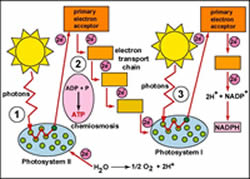Difference between Photosystem I and Photosystem II
Key difference: The photosystem I was named “I” as it was discovered before photosystem II. However, during the process of photosynthesis, photosystem II comes into play before photosystem I. The main difference between the two is the wavelengths of light to which they respond. Photosystem I absorbs light with wavelengths shorter than 700 nm, whereas photosystem II absorbs light with wavelengths shorter than 680 nm. However, they are both equally important in the process of oxygenic photosynthesis.
 Photosystems are an essential and functional part of the photosynthesis process. Photosynthesis is Greek for “composition of light”. It is a process used by plants and other organisms to convert light into food. It actually allows the plants and organisms to collect the light energy from the sun and turn it into chemical energy. This chemical energy can then be used to fuel the plant’s and organism's activities.
Photosystems are an essential and functional part of the photosynthesis process. Photosynthesis is Greek for “composition of light”. It is a process used by plants and other organisms to convert light into food. It actually allows the plants and organisms to collect the light energy from the sun and turn it into chemical energy. This chemical energy can then be used to fuel the plant’s and organism's activities.
Plants, algae, and many species of bacteria partake in the process of photosynthesis. It is one of the main sources of energy for plants and most other types of bacteria. In order for plants and cyanobacteria to perform oxygenic photosynthesis, they need both photosystems I and II. Oxygenic photosynthesis uses carbon dioxide and water to produce oxygen and energy.
Photosystems are structural units of protein complexes that are involved in photosynthesis. They carry out the primary photochemistry of photosynthesis, that is, the absorption of light and the transfer of energy and electrons. In plants and algae, the photosystems are located in the chloroplasts, whereas, in photosynthetic bacteria, they can be found in the cytoplasmic membrane.
The photosystem I was named “I” as it was discovered before photosystem II. However, during the process of photosynthesis, photosystem II comes into play before photosystem I. The main difference between the two is the wavelengths of light to which they respond. Photosystem I absorbs light with wavelengths shorter than 700 nm, whereas photosystem II absorbs light with wavelengths shorter than 680 nm. However, they are both equally important in the process of oxygenic photosynthesis.
Photosystem I contains the chlorophyll-A molecule P700, which absorbs wavelengths shorter than 700 nm. It receives energy from photons, in addition to the associated accessory pigments in its antenna system, and from the electron transport chain from Photosystem II. It uses the energy from light to reduce NADP+ (nicotinamide adenine dinucleotide phosphate) to NADPH + H+, or simply to power a proton pump (plastoquinone, or PQ).
Photosystem II, which is the first protein complex in the light-dependent photosynthesis, contains the chlorophyll-A molecule P680 that absorbs light with wavelengths shorter than 680 nm. It receives energy from photons and from associated accessory pigments in its antenna system and uses it to oxidize water molecules, producing protons (H+) and O2 as well as passing an electron to the electron transport chain.

In the process of photosynthesis, the photosystem II absorbs light, using which the electrons in the reaction-center chlorophyll are excited to a higher energy level and are trapped by the primary electron acceptors. In photosystem II, cluster of four Manganese ions extract electrons from water, which are then supplied to the chlorophyll via a redox-active tyrosine.
The electrons are then photoexcited, which travel through the cytochrome b6f complex to photosystem I through an electron transport chain set in the thylakoid membrane. The energy of the electrons is then harnessed through a process called chemiosmosis. The energy is used to transport hydrogen (H+) through the membrane, to the lumen, in order to provide a proton-motive force to generate ATP. ATP is generated when the ATP synthase transports the protons present in the lumen to the stroma, through the membrane. The protons are transported by the plastoquinone. If electrons only pass through once, the process is termed noncyclic photophosphorylation.
After the electron reaches photosystem I, it fills the reaction-center chlorophyll of photosystem I. The electrons are then photoexcited and are trapped in an electron acceptor molecule of the photosystem I. The electrons may either continue to go through cyclic electron transport around PS I or pass through the ferredoxin to the enzyme NADP+ reductase. The electrons and hydrogen ions are added to NADP+ to form NADPH, which is then transported to the Calvin cycle to react with glycerate 3-phosphate, along with ATP to form glyceraldehyde 3-phosphate. The glyceraldehyde 3-phosphate is the basic building-block which can be used by the plants to make a variety of substances.
Image Courtesy: factmonster.com, biologycorner.com









Comments
This is the most simple and helpful information I have found! Very helpful.
Katelyn Charlton
Sun, 05/11/2014 - 07:18
Add new comment